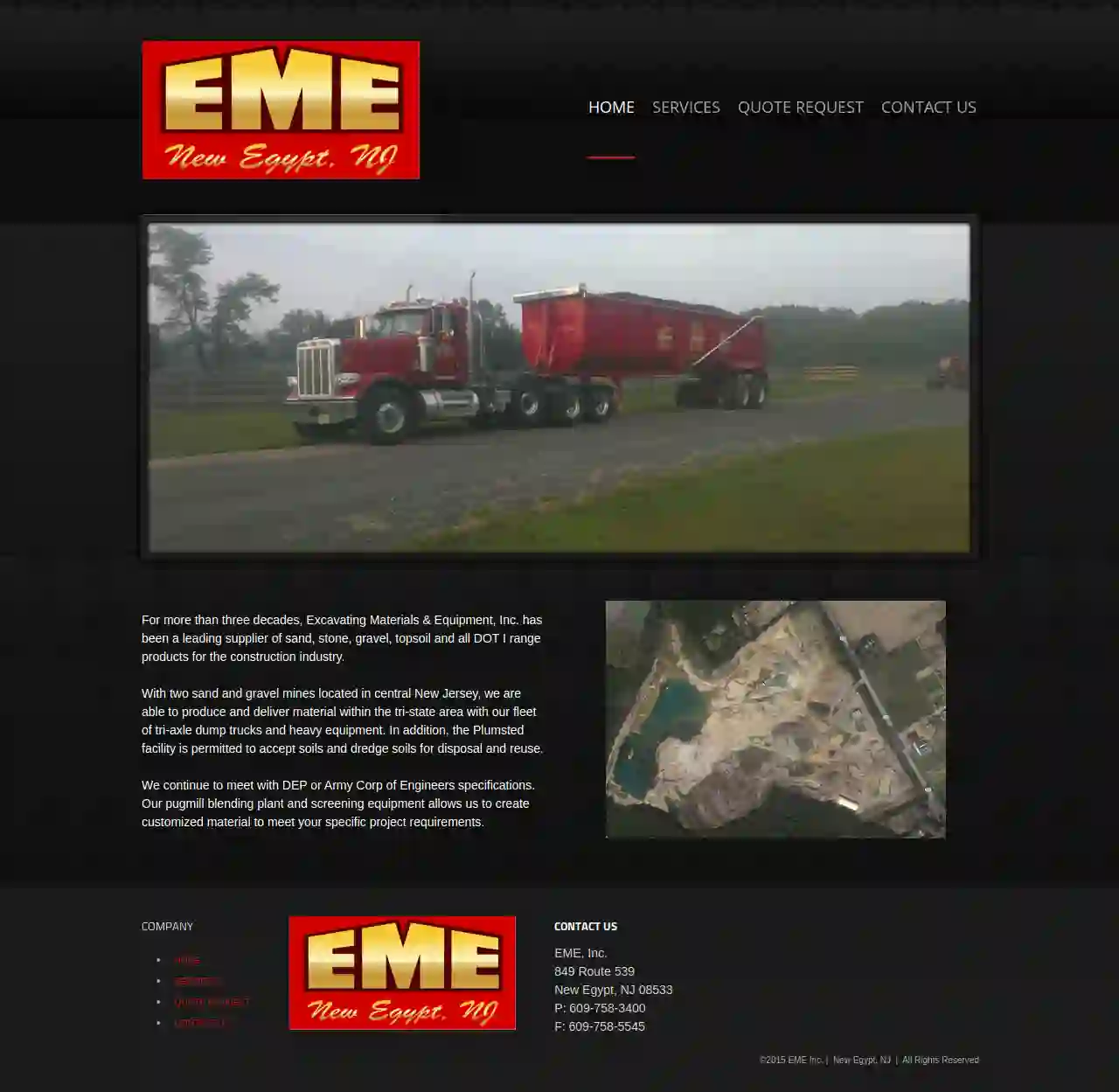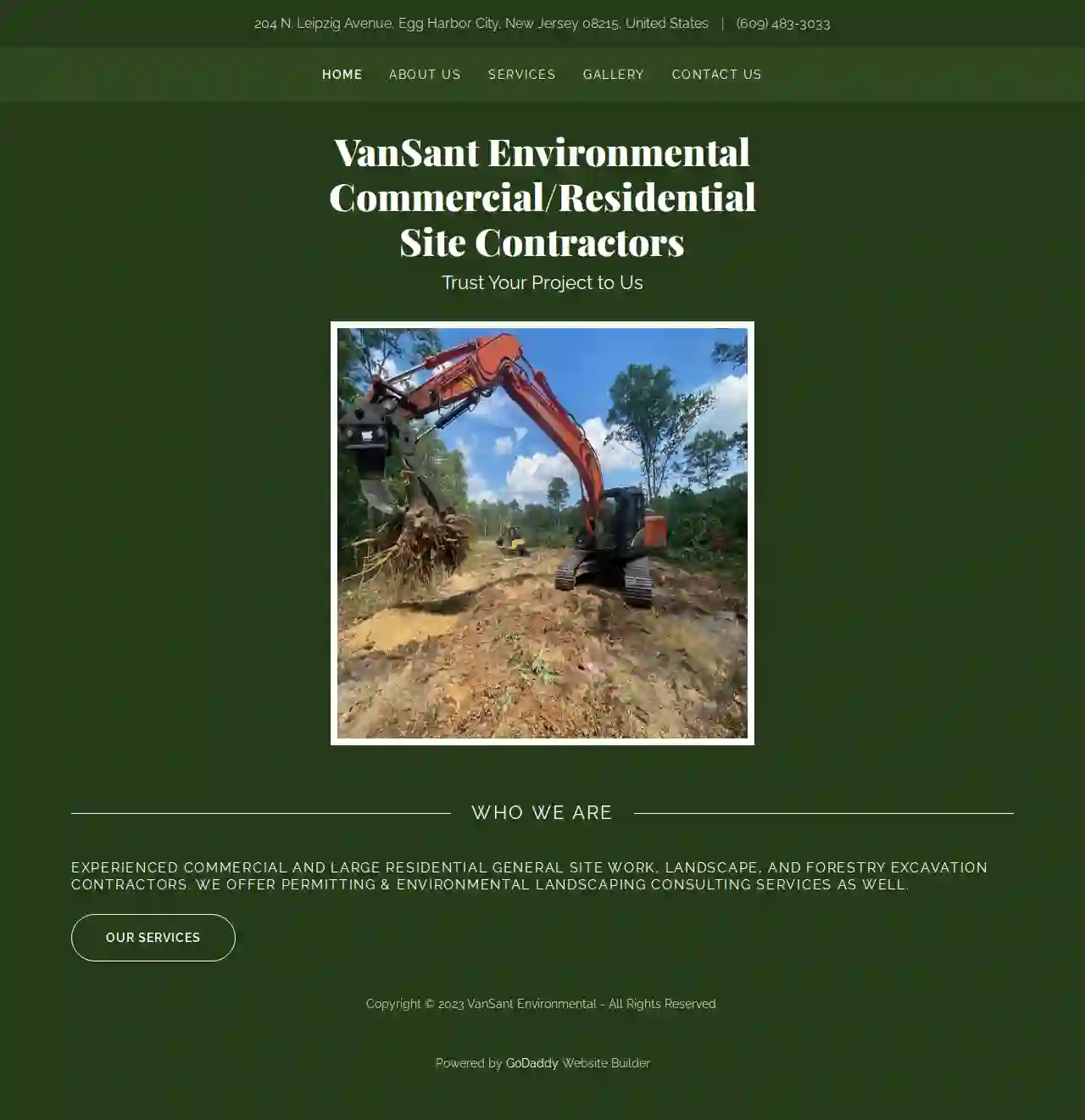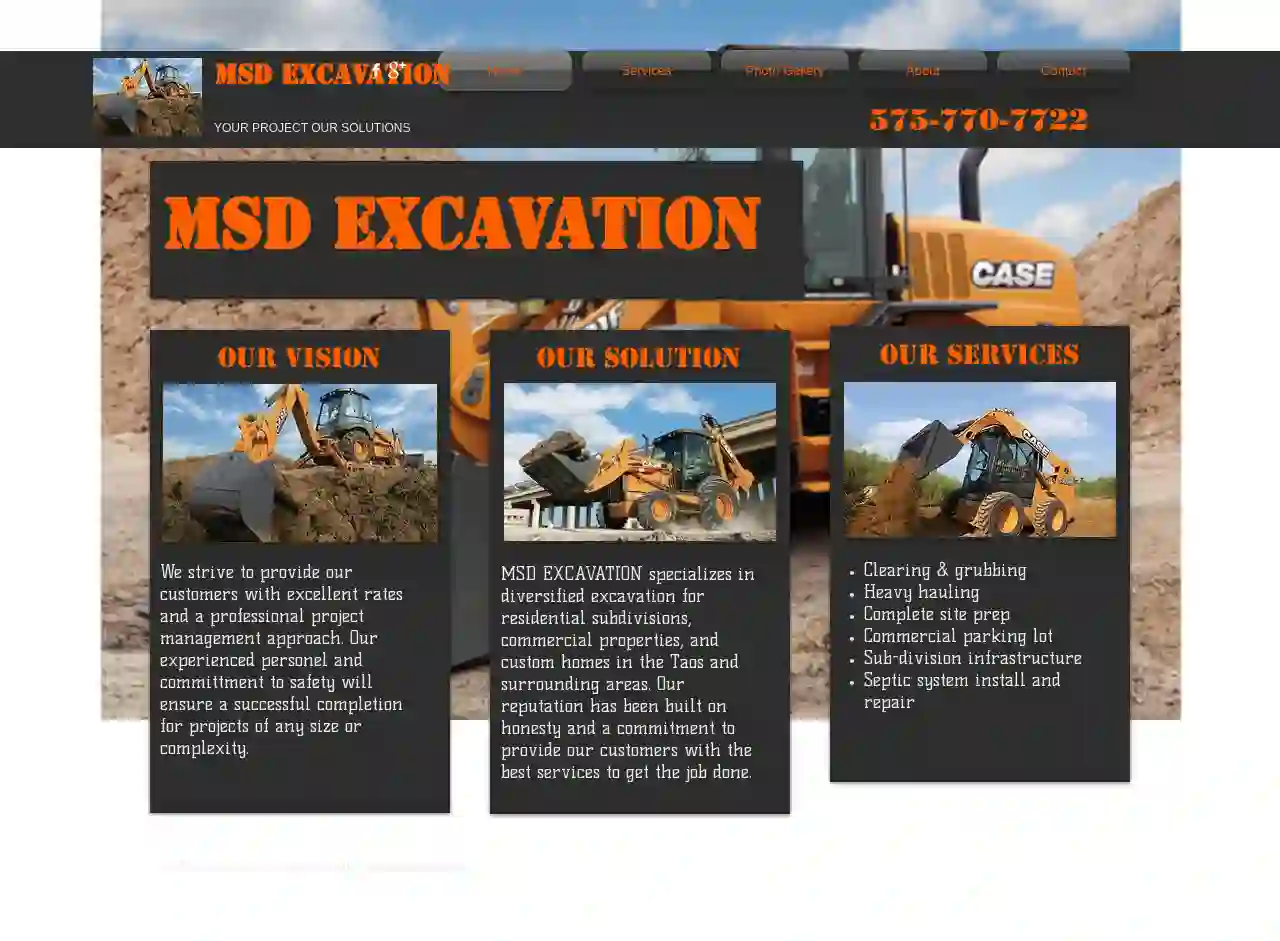Excavation Contractors Aberdeen
Find the best Excavation Company Near Me in Aberdeen
Receive up to 3 Land Excavation quotes for your project today! Compare profiles, reviews, accreditations, portfolio, etc... and choose the best service.

Excavating Materials & Equipment, Inc.
37 reviews849 Route 539, New Egypt, 08533, USExcavating Materials & Equipment, Inc. (EME) For over three decades, EME has been a leading supplier of sand, stone, gravel, topsoil, and DOT I range products for the construction industry in central New Jersey. We operate two sand and gravel mines, ensuring we can efficiently produce and deliver materials within the tri-state area using our fleet of tri-axle dump trucks and heavy equipment. Our commitment to quality extends beyond material supply. The Plumsted facility is permitted to accept soils and dredge soils for disposal and reuse, adhering to strict DEP and Army Corp of Engineers specifications. Our pugmill blending plant and screening equipment allow us to create customized materials tailored to your specific project requirements.
- Services
- Why Us?
- Gallery
Get Quote
Torshel Tornado Shelters & Safe Rooms
53 reviewsBrick, USThe fastest way to get your storm shelter is by selecting the product or products of your interest. Then, proceed to fill out the contact form online, and a sales representative will be in touch with you. The installation time for the above and in-ground units is 1-3 weeks, depending on your location. Commercial building installation time is 3-6 weeks, depending on the size and your location. If you are building a house, make sure that you order your storm shelter ahead of time. Thank you very much, stay safe! Financing Options We’ve Been Protecting Families & Businesses For Over 9 Years Buying a storm shelter is an important decision. Torshel is committed to helping you choose the best type of shelter for both your home and budget. Both underground shelters and safe rooms offer maximum protection for storms. We encourage our clients to compare the quality of our shelters, methods of installation, and the reputation of the companies. There have been a few cases where other companies have poorly installed in-ground shelters that slip out of the ground. As a result, people can be terribly injured, and in some cases, death may occur. Some companies put profit over the lives of those who will use their products. At Torshel we work to make sure that we save and help protect as many lives as possible. We only install the highest quality storm shelters available in the market and stand behind our work by offering a 10-year warranty. We make ourselves available before and after the shelter’s installation. Commercial and Residential Storm Shelters Welcome to Torshel Storm Shelters, a leading company in the storm shelter and safe room industry. We have the best products, at an affordable price. We proudly install and serve Alabama, Arkansas, Florida, Kentucky, Louisiana, Mississippi, Tennessee, Texas, Georgia, and surrounding states. However, we sell, and ship storm shelters anywhere in the United States. We have clients in Dallas, New York, Miami, Seattle, Los Angeles, and many rural areas around the country. Enjoy your visit to our website. Take a look at our videos, pictures, and testimonials from multiple clients. We know this is an important decision. Know that if you chose us, you will get great customer service and a top-of-the-line storm shelter backed by a 10-year warranty. Torshel offers discounts to customers who purchase two or more units. Protect your family with a Torshel shelter manufactured to withstand EF5 category tornadoes. Torshel offers underground storm shelters and above-ground safe rooms of various sizes that meet or exceed FEMA’s stringent safety standards. Our tornado shelters are also more durable than traditional storm cellars. Let your neighbors, coworkers, and friends know about your purchase of your storm shelter. If they want to buy one during the same delivery and installation trip, everyone can save a lot. A case in point, Mr. Kyle told Mr. Will about his new in-ground shelter; Will liked the product and decided to purchase one. Torshel delivered and installed two units, and offered them discounts! John and George partnered installing a big shelter in-between their houses, both saved and both of their families can have direct access to the shelter. Commercial Storm Shelters The most valuable asset of any company is not its facilities, machines or products. It’s their team of employees, executives, and clients. Torshel can help protect them while at work with a commercial multipurpose storm shelter, panic room, and safe vault in the event of a tornado, hurricane, robberies, shootings, and other types of incidents that may put in danger their safety. You, your staff, and clients will have a peace of mind by having a steel safe room ready for any threating occasion. Storm Shelter in your Garage Torshel storm shelters are made of structural heavy-duty steel and are one of the bests available in the United States. Our storm shelters are well constructed and properly anchored. Such units will withstand an EF5 tornado according to engineers and professionals at Texas Tech University. They are the perfect solution for the elderly, people with disabilities, claustrophobia, and clients who want an easy to reach safe room in their garage. Inground Tornado Shelters For clients that live in mobile homes, or do not have a garage, we offer underground outdoor shelters. These underground units reflect Torshel’s latest technology. They come with a 13” x 13” bullet-resistant window made of 1.5” polycarbonate. The window allows natural light to flow inside the shelter. You won’t feel entrapped. Torshel’s Newest and High Technology Feature! 4-6 cubic yards of 3,000 PSI concrete will keep the unit inside the ground and prevent it from floating. Let’s Keep Your Family Safe The sooner the better, fill our online form and one of our talented representatives will contact you to help you with any question you might have.
- Services
- Why Us?
- Testimonials
- Gallery
Get Quote
Blackwater Draw Locality 1
4.556 reviews1500 S. Ave K, Lea Hall Room 163, Portales, 88130, USThe Blackwater Draw Museum seeks to foster preservation and education of the heritage of New Mexico, the Southern High Plains, and the greater Southwest through exhibitions, educational programs, collections, and research, while enriching and supporting the educational goals and mission of ENMU. The Blackwater Draw Museum is a small museum located on the campus of Eastern New Mexico University in Portales, New Mexico. The museum is home to a collection of artifacts from the Blackwater Draw National Historic Landmark, a site that has been inhabited by humans for over 13,500 years. The museum offers a variety of exhibits, educational programs, and research opportunities. Visitors can learn about the history of the Blackwater Draw site, the cultures that have lived there, and the archaeology of the region. The museum also has a collection of artifacts from the Casas Grandes culture, a prehistoric culture that flourished in the Southwest from about 1300 to 1450 AD. The museum is open to the public and offers a variety of tours and programs. The museum is a great place to learn about the history and culture of the Southwest. The Blackwater Draw Museum is a great place to learn about the history and culture of the Southwest. The museum offers a variety of exhibits, educational programs, and research opportunities. Visitors can learn about the history of the Blackwater Draw site, the cultures that have lived there, and the archaeology of the region. The museum also has a collection of artifacts from the Casas Grandes culture, a prehistoric culture that flourished in the Southwest from about 1300 to 1450 AD. The museum is open to the public and offers a variety of tours and programs.
- Services
- Why Us?
- Gallery
Get Quote
The New Mexico Office of Archaeological Studies
4.312 reviews7 Old Cochiti Road, Santa Fe, 87507, USAbout the Office of Archaeological Studies The New Mexico Office of Archaeological Studies (OAS) conducts archaeological research projects throughout New Mexico with a diverse group of 13 archaeologists and support staff. Our mission is to identify, interpret, and share information about prehistoric and historic sites across the state. OAS serves other State agencies and private organizations that require archaeological studies as part of their development projects. In addition, we provide ethnographic and historical research services and have an education outreach program that directly interacts with New Mexicans in order to answer their questions about archaeology, history, and the heritage of New Mexico. That program twice received the Society for American Archaeology’s Excellence in Public Education Award, in 2005 and again in 2012. In addition to client-initiated projects, OAS conducts research projects that are funded by grants and private donations. Many of the projects make use of a dedicated corps of volunteers or involve our many research associates. OAS provides training opportunities for university students and makes use of their skills in the latest technology. We also engage in educational outreach programs in surrounding states. OAS has five specialized laboratories, a research library, and a publications department. Our archaeomagnetic dating laboratory is one of two full-time laboratories in the United States that are dedicated to this dating technique and our low-energy plasma radiocarbon sampling laboratory enables us to nearly non-destructive date fragile archaeological materials. Departmental Overview The New Mexico Office of Archaeological Studies has been providing cultural resource management services throughout New Mexico since 1952. OAS continues to fulfill the Museum of New Mexico’s commitment to the highway archaeology program and has expanded to include a diverse client base. Our list of clients spans the breadth of private and public customers, yet much of the work that we have completed is for return clients. Since 1952 OAS archaeologists have conducted over 800 archaeological projects and produced nearly 1,000 reports. We have worked throughout New Mexico, adjacent states, and northern Mexico, with reports available on projects in all areas.
- Services
- Why Us?
- Gallery
Get Quote
VanSant Environmental Landscaping & Site Work
51 reviews204 North Leipzig Avenue, Galloway, 08215, USWho We Are Experienced Commercial and LARGE Residential General Site work, Landscape, and Forestry EXCAVATION Contractors. We offer permitting & environmental landscaping consulting services as well. Our Team Barry VanSant Barry is the owner and the company's Horticulturist and Landscape Designer/Consultant. He has over 45 years experience in multiple areas of the industry. Samuel VanSant Sam is the company's Project and Construction Manager. He oversees the day-to-day operations and all heavy equipment operations. Adam Wolff Adam is our field engineer. He is a graduate of East Carolina University in construction management and LEED Certified. Frequently Asked Questions Are you insured and licensed? We have all necessary licenses for our area, and we carry insurance for all of our projects. What kind of landscaping do you do? Our specialty is in natural and native plant material and methods that fit the ecology of our area. We proudly support and volunteer for: Team Rubicon USA Volunteer Partner Since Oct. 2016 Habitat For Humanity Volunteer Partner Since Oct. 2016 U.S. Fish and Wildlife Services Volunteer Partner Since Dec. 2018
- Services
- Why Us?
- Our Team
- Gallery
Get Quote
W.G. Yates & Sons Construction Company
4.624 reviews104 Gully Avenue, Philadelphia, MS 39350, 39350, USYates Construction: Building the Future Yates Construction is a leading general contractor specializing in the construction of complex, large-scale projects across the United States. With a rich history spanning decades, we have established a reputation for delivering exceptional results, exceeding client expectations, and fostering lasting relationships. Our Mission Our mission is to provide our clients with the highest quality construction services, delivered on time and within budget. We are committed to safety, integrity, passion, and commitment in everything we do. Our Experience Yates Construction has a proven track record of success in a wide range of market sectors, including: E-Commerce Distribution Facilities Hospitality Gaming Technology Centers Industrial Healthcare Education Government Commercial Our Team Our team of experienced professionals is dedicated to providing our clients with the highest level of service. We are committed to building strong relationships with our clients and subcontractors, and we believe that collaboration is key to success.
- Services
- Why Us?
- Gallery
Get Quote
Next Level Excavation
54 reviewsEgg Harbor Township, USFamily owned and operated Bring your projects to the Next Level Who we are Doug is the owner and operator of Next Level Excavation. Doug has over 18 years experience in all types of excavation. From small residential projects to large commercial projects we have you covered! Safety is our standard. All employees are O.S.H.A. Certified Fully licensed and insured Over 18 years of experience Services Excavator and skid steer services Brush removal Bulk trash hauling Concrete removal Drainage systems Fence/deck/shed demolition and removal Trenching of any kind Stone driveways Grading Dump trailer rental Material hauling Much more… Prompt and Reliable Satisfaction Guaranteed
- Services
- Why Us?
- Our Team
- Gallery
Get Quote
Mississippi 811, Inc.
4.823 reviews200 Country Pl Pkwy, Pearl, 39208, USAbout MS811 MS811 is a vital resource for anyone planning to dig in Mississippi. Our mission is to protect underground infrastructure and ensure the safety of excavators, homeowners, and the public. We provide a free, easy-to-use service that helps you locate underground utilities before you dig. By calling 811 or visiting our website, you can request a locate request and ensure that you are digging safely. We are committed to providing our customers with the highest level of service and support. Our team of experts is available 24/7 to answer your questions and help you navigate the process of digging safely. We also offer a variety of resources and information to help you understand the importance of damage prevention and the laws and regulations that govern excavation in Mississippi. We believe that everyone has a role to play in protecting underground infrastructure. By working together, we can prevent damage to utilities and ensure the safety of our communities.
- Services
- Why Us?
- Gallery
Get Quote
MSD EXCAVATION
525 reviewsFranklin, USOur Vision We strive to provide our customers with excellent rates and a professional project management approach. Our experienced personnel and commitment to safety will ensure a successful completion for projects of any size or complexity. Our Solution MSD EXCAVATION specializes in diversified excavation for residential subdivisions, commercial properties, and custom homes in the Taos and surrounding areas. Our reputation has been built on honesty and a commitment to provide our customers with the best services to get the job done.
- Services
- Why Us?
- Gallery
Get Quote
Del Casale Excavating
511 reviews1000 County Route 106, Clifton Park, 12180, USDel Casale Excavating: Your Trusted Partner for Excavation Services Del Casale Excavating is a family-owned and operated business with over 20 years of experience in the excavation industry. We are committed to providing our clients with high-quality, reliable, and affordable services. Our team of experienced professionals is dedicated to exceeding your expectations and delivering exceptional results. We understand that every project is unique, and we take the time to listen to your needs and develop a customized plan that meets your specific requirements. Whether you need site preparation, foundation excavation, utility installation, or any other excavation service, we have the expertise and equipment to handle the job efficiently and effectively. At Del Casale Excavating, we are committed to safety and environmental responsibility. We use the latest technology and equipment to minimize our impact on the environment and ensure the safety of our workers and the public. Contact us today for a free consultation and let us help you bring your project to life.
- Services
- Why Us?
Get Quote
Over 22,076+ Excavation Contractors in our network
Our excavation companies operate in Aberdeen and beyond!
ExcavationHQ has curated and vetted the Best Excavation Businesses in Aberdeen. Find a top & reliable contractor today.
Frequently Asked Questions About Excavation Contractors
- Determining Soil Suitability: Assessing whether the soil can support the intended structure or load.
- Recommending Foundation Types: Advising on the appropriate foundation design based on soil characteristics.
- Addressing Drainage and Erosion Issues: Providing solutions to manage water runoff and prevent erosion.
- Evaluating Slope Stability: Assessing the risk of landslides or soil movement on slopes.
- Building on challenging soil types (expansive clay, loose sand, etc.)
- Constructing large or complex structures
- Excavating near slopes or retaining walls
- Addressing drainage or erosion concerns
- Spring and Fall: Often considered favorable due to moderate temperatures and drier soil conditions.
- Summer: Can be suitable, but hot weather can make working conditions challenging and might require additional measures (shade, hydration) for workers.
- Winter: Excavation in winter can be more difficult due to frozen ground, snow, and potential delays caused by inclement weather. It might also require specialized equipment or techniques.
- Excavators: Versatile machines with a bucket, arm, and rotating cab for digging, lifting, and moving earth.
- Backhoes: Similar to excavators but with a digging bucket on the back and a loader bucket on the front, ideal for trenching and smaller excavations.
- Bulldozers: Powerful machines with a large blade for pushing earth, clearing land, and leveling surfaces.
- Skid Steers: Compact and maneuverable loaders with various attachments (buckets, forks) for digging, loading, and grading in tight spaces.
- Trenchers: Specialized machines for digging narrow trenches for utilities.
- Dump Trucks: Vehicles for hauling excavated material to disposal sites.
- Mechanical Excavation: Utilizing heavy equipment like excavators, backhoes, bulldozers, and loaders, suitable for most projects.
- Hand Excavation: Using hand tools (shovels, picks) for smaller excavations or delicate work near utilities.
- Blasting: Employing explosives to break up rock or hard materials, typically for large-scale projects.
- Hydro Excavation: Using high-pressure water jets to loosen and remove soil, often used for locating utilities or delicate excavation.
- Vacuum Excavation: Employing a vacuum system to suck up excavated material, suitable for safe excavation near utilities or in confined spaces.
What is a soil engineer, and do I need one?
What is the best time of year for excavation?
What equipment is used for excavation?
What are the different methods of excavation?
What is a soil engineer, and do I need one?
- Determining Soil Suitability: Assessing whether the soil can support the intended structure or load.
- Recommending Foundation Types: Advising on the appropriate foundation design based on soil characteristics.
- Addressing Drainage and Erosion Issues: Providing solutions to manage water runoff and prevent erosion.
- Evaluating Slope Stability: Assessing the risk of landslides or soil movement on slopes.
- Building on challenging soil types (expansive clay, loose sand, etc.)
- Constructing large or complex structures
- Excavating near slopes or retaining walls
- Addressing drainage or erosion concerns
What is the best time of year for excavation?
- Spring and Fall: Often considered favorable due to moderate temperatures and drier soil conditions.
- Summer: Can be suitable, but hot weather can make working conditions challenging and might require additional measures (shade, hydration) for workers.
- Winter: Excavation in winter can be more difficult due to frozen ground, snow, and potential delays caused by inclement weather. It might also require specialized equipment or techniques.
What equipment is used for excavation?
- Excavators: Versatile machines with a bucket, arm, and rotating cab for digging, lifting, and moving earth.
- Backhoes: Similar to excavators but with a digging bucket on the back and a loader bucket on the front, ideal for trenching and smaller excavations.
- Bulldozers: Powerful machines with a large blade for pushing earth, clearing land, and leveling surfaces.
- Skid Steers: Compact and maneuverable loaders with various attachments (buckets, forks) for digging, loading, and grading in tight spaces.
- Trenchers: Specialized machines for digging narrow trenches for utilities.
- Dump Trucks: Vehicles for hauling excavated material to disposal sites.
What are the different methods of excavation?
- Mechanical Excavation: Utilizing heavy equipment like excavators, backhoes, bulldozers, and loaders, suitable for most projects.
- Hand Excavation: Using hand tools (shovels, picks) for smaller excavations or delicate work near utilities.
- Blasting: Employing explosives to break up rock or hard materials, typically for large-scale projects.
- Hydro Excavation: Using high-pressure water jets to loosen and remove soil, often used for locating utilities or delicate excavation.
- Vacuum Excavation: Employing a vacuum system to suck up excavated material, suitable for safe excavation near utilities or in confined spaces.